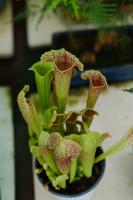Is the Water Potential of Different Plant Cells the Same?
Water potential is the measure of the free energy of water molecules in a solution. In plants, water moves through the plant body due to differences in water potential between different plant cells. The water potential of a plant cell depends on several factors, such as the concentration of solutes, pressure, and the type of plant cell. Therefore, it is essential to understand whether the water potential of different plant cells is the same.
The Types of Plant Cells
There are two types of plant cells: the parenchyma and the specialized cells. Parenchyma cells are the most common type of plant cell and are responsible for the photosynthesis process, which produces food for the plant. Specialized cells, on the other hand, have specific functions and include xylem and phloem cells, which transport water and nutrients throughout the plant, and epidermal cells, which are responsible for protecting the plant from environmental factors.
Differences in Water Potential between Parenchyma and Specialized Cells
The water potential of a plant cell is mainly determined by two factors: pressure and concentration. In general, the water potential of parenchyma cells is higher than that of specialized cells. This is because the solute concentration in specialized cells is usually much higher than that in parenchyma cells. The high solute concentration in specialized cells makes water move from high to low water potential, which means water moves from the parenchyma cells to specialized cells through osmosis.
The Role of Pressure in Water Potential
Pressure also plays a role in determining the water potential of plant cells. The pressure potential of a cell is the pressure exerted by the cell wall on the cell membrane, which counteracts the movement of water. If the pressure in a cell is high, the water potential will also be high. For example, xylem cells, which transport water from the roots to the leaves, have high pressure potential due to the strong cell walls that support them.
The Impact of Water Potential on Plant Growth and Health
Different plants have different water potential requirements. Plants with lower water potential requirements can tolerate drought conditions, while plants with higher water potential requirements need to be in a moist environment to thrive. The water potential of plant cells also affects cell growth and turgor pressure. When a plant cell has a lower water potential than the environment, it loses water, and its turgor pressure decreases, which can lead to wilting and other adverse effects.
Conclusion
In conclusion, the water potential of different plant cells is not the same. Parenchyma cells generally have a higher water potential than specialized cells due to differences in solute concentration. Pressure also plays a role in determining the water potential of plant cells. Understanding the water potential of different plant cells is important for optimizing plant growth and health, as well as for understanding how water moves through the plant body.

 how many times do yo...
how many times do yo... how many planted tre...
how many planted tre... how many pine trees ...
how many pine trees ... how many pecan trees...
how many pecan trees... how many plants comp...
how many plants comp... how many plants can ...
how many plants can ... how many plants and ...
how many plants and ... how many pepper plan...
how many pepper plan...




























